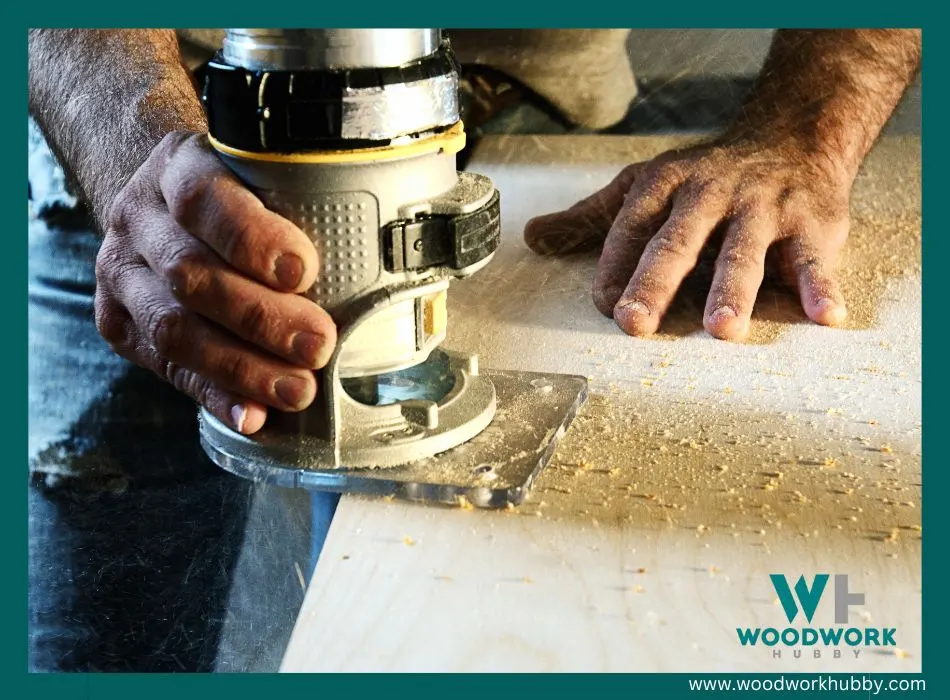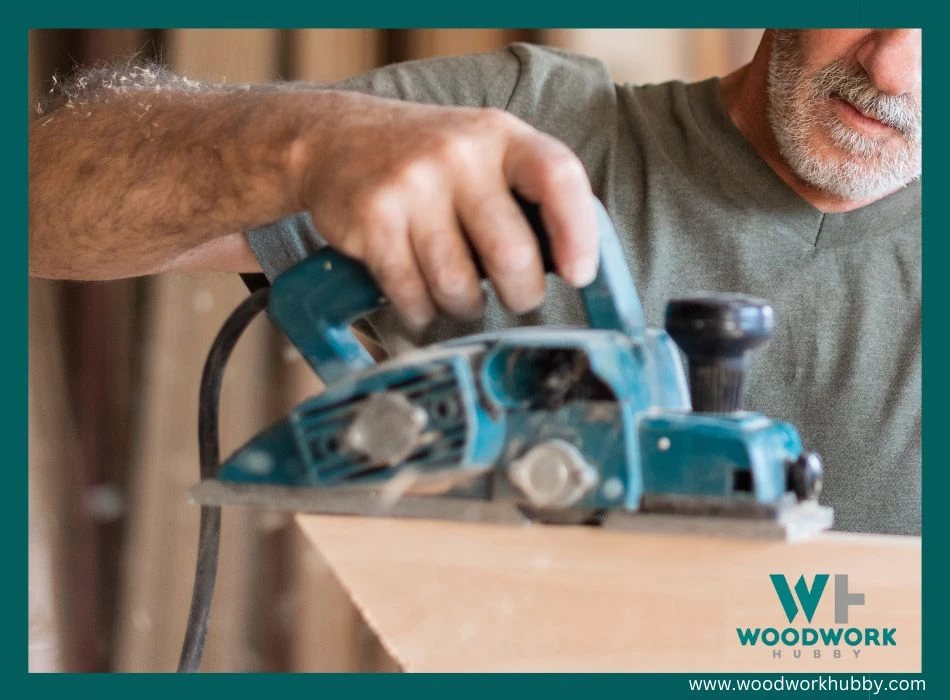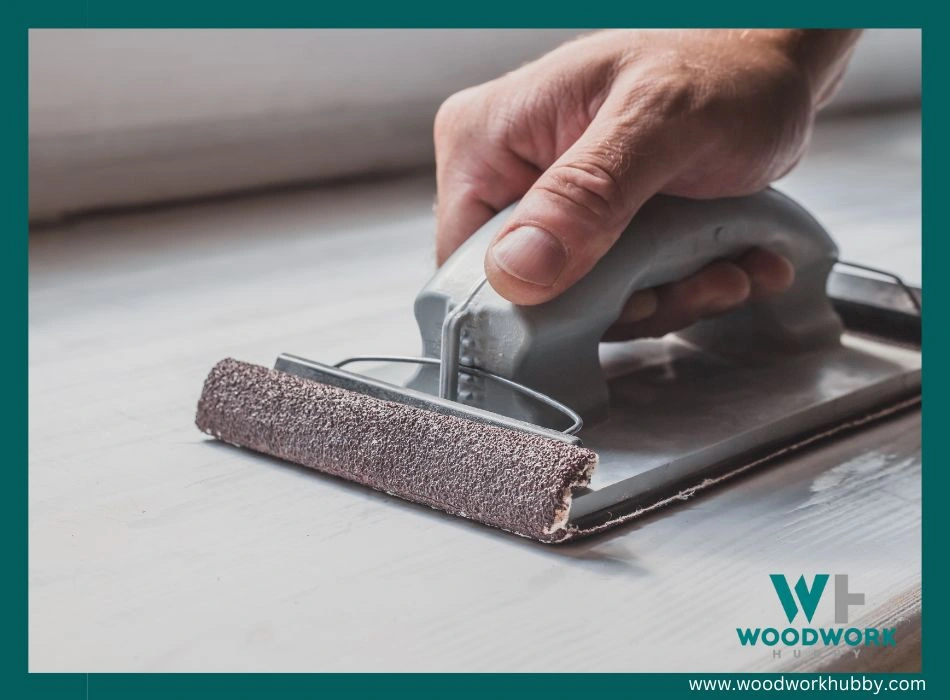Are you eager to start a woodworking project, but lack an essential tool – the planer? I know that frustration all too well; after tackling this obstacle myself and researching extensively, I’ve found that there’s more than one way to achieve that smooth finish.
This article will guide you through seven effective methods of planing wood without ever needing a conventional planer.
Key Takeaways
- Planing wood is crucial for achieving a smooth and uniform surface in woodworking projects.
- There are several effective methods to plane wood without a planer, including using a table saw, router, hand plane, drum sander, sandpaper, moisture method, and hand saw with a straight edge.
- Each method has its advantages and limitations, but with practice and patience, you can achieve professional results without relying on expensive power tools.
- Safety precautions should always be followed when using power tools or handling sharp objects.
Importance of Planing Wood
Planing wood is an essential step that establishes the foundation for many woodworking projects. It helps craft a uniform thickness across all pieces of wood and leaves you with a smooth surface ideal for applying finishes or paint.
A well-planed piece of lumber provides precision in your carpentry project, where everything fits together flawlessly due to consistent measurements. Unfortunately, not every DIY enthusiast or professional cabinet maker has access to power planers, which creates the need for mastering alternative methods.
Video showing how to plane wood without a planer
This versatile process gives you a chance to enhance your woodworking skills and patience even further as it necessitates precision and attention to detail far beyond any other stage in a woodworking project.
Different Ways to Plane Wood without a Planer
In this section, we will explore seven effective methods to plane wood without a planer, including using a table saw, utilizing a router, applying a hand wood planer, employing a drum sander, resorting to sandpaper, the moisture method for warped wood, and using a hand saw with a straight edge.
1. Using a Table Saw
Starting the process of planing wood without a planer can initially seem daunting, but with the right tools and a little patience, it’s entirely achievable. Here’s how you can achieve it using a table saw:

- Ensure you have an appropriate workspace with sufficient lighting and ventilation.
- Gather your woodworking tools; for this method you’ll need a table saw and some engineering squares.
- Start by building a sturdy jig for your table saw to safely hold the board in position. Use scraps of lumber or repurposed lumber, taking care to ensure the design promises stability.
- Next step is about setting up your saw blade correctly; use an engineering square to check and adjust the blade position to attain perfect 90 degrees.
- Begin practicing with scrap pieces of wood before moving on to your main piece. This will help you refine your woodworking techniques, giving you better control over your tools.
- Once comfortable, start running the actual wood through the table saw; ensure that you’re moving the board smoothly against the grain, not against it.
- Check for any burn marks or flaws on the surface caused by improper blade angle or movement; these usually occur if the board is not moved evenly against the saw.
- Remember that safety is paramount: always wear proper safety gear including goggles and gloves when operating power tools like a table saw.
2. Utilizing a Router
To plane wood without a planer, you might opt to use a wood router, which is an effective alternative. Here’s how:

- Start by constructing a jig: A properly constructed router jig can provide the perfect setup for planing your wood.
- Make sure your wooden frame is sturdy: The rigidity of the wooden frame will ensure that the router moves smoothly across the surface of the wood.
- Choose the right router bit: This is essential in achieving a smooth surface.
- Practice with a scrap piece of wood: This will help you refine your technique before starting on your actual piece.
- Follow the grain direction: Always move your router with the grain of the wood instead of against it.
- Keep safety in mind: As with any power tool, wear goggles and gloves when operating your tool to prevent woodworking injuries.
Video on how to flatten a board without a planer
3. Applying a Hand Wood Planer
Applying a hand wood planer allows for precision and control in planing wood without a planer. Here are the steps to use a hand wood planer:

- Select the appropriate hand plane: Choose a hand plane based on the size and condition of the wood you are working with. A jack plane, jointer plane, or scrub plane may be suitable options.
- Prepare the wood: Ensure that the wood is securely fastened or clamped to a work surface to prevent movement during planing.
- Assess the direction of the grain: Examine the grain of the wood and identify its direction. Planing against the grain can lead to tear-out and an uneven surface.
- Adjust the blade position: Set the depth of cut by adjusting the position of the blade in relation to the sole of the hand plane. Start with a shallow cut and gradually increase it until desired thickness is achieved.
- Start planing: Hold onto both handles of the hand plane firmly, using one hand on each side. Begin planing at one end of the wood, applying steady pressure as you push forward along its length.
- Move in long, smooth strokes: Maintain consistent pressure and push smoothly across the surface of the wood, keeping your arms parallel to maintain even pressure distribution.
- Check for high spots: Periodically stop planing to inspect for any high spots or areas that require further attention. Adjust your technique or blade position accordingly.
- Repeat as necessary: Continue planing until you achieve your desired level of thickness and smoothness across all areas of the wood.
4. Employing a Drum Sander
When it comes to planing wood without a planer, one effective alternative is employing a drum sander. Here’s how you can use this tool to achieve the desired results:

- Set up the drum sander: Ensure that the drum sander is securely mounted on a stable workbench or table. Make sure it is properly adjusted and in good working condition.
- Prepare the wood: Start by ensuring that your wood piece is clean and free from any debris or loose particles. It’s best to remove any nails or staples before proceeding.
- Begin sanding: Turn on the drum sander and gently feed the wood into the machine, moving it back and forth along the length of the board. Keep a steady pace to ensure consistent removal of material.
- Check for evenness: Periodically check the surface of the wood to ensure that it is being evenly planed by the drum sander. Make any necessary adjustments if you notice uneven spots or inconsistencies.
- Repeat if needed: Depending on your desired level of planing, you may need to make multiple passes with the drum sander until you achieve your desired thickness and smoothness.
- Finish sanding: Once you’ve achieved your desired level of planing with the drum sander, finish off by using finer-grit sandpaper or other finishing techniques to further smooth out any rough patches.
5. Resorting to Sandpaper
When it comes to planing wood without a planer, one option you can consider is resorting to sandpaper. Sandpaper can be a useful tool for smaller projects or for finishing touches. Here are some steps to follow when using sandpaper to plane wood:

- Start with coarse sandpaper: Begin by using the coarsest grit sandpaper available, such as 60 or 80 grit. This helps remove material quickly and efficiently.
- Sand in the direction of the grain: Always sand in the same direction as the wood grain to avoid causing damage or creating uneven surfaces.
- Apply even pressure: Apply even pressure while sanding, ensuring that you cover the entire surface evenly. This helps achieve a smooth and uniform result.
- Progress through finer grits: As you progress, switch to progressively finer grits of sandpaper, such as 120, 220, and so on. This helps refine the surface and remove any marks left by the coarser grits.
- Check for high spots: Keep checking for any high spots or areas that need more attention while sanding. Mark these areas and continue until the surface is flat and smooth.
- Use a sanding block: To ensure even pressure distribution, wrap the sandpaper around a sanding block or use a sanding block with an attached handle.
Video explaining how to flatten a slab without a planer
6. Moisture Method
The moisture method is a technique used to straighten out warped wood without changing its thickness. This method is particularly useful for small projects or for pieces of wood that cannot be easily planed with traditional methods. Here’s how you can use the moisture method to plane wood:
- Start by wetting the concave side (the side that curves inward) of the warped wood using a spray bottle or a sponge. Make sure to wet it thoroughly.
- Then, place the wet side of the wood on a flat surface such as a workbench or concrete floor with towels underneath to absorb excess moisture.
- Apply heat to the convex side (the side that curves outward) of the wood using heating sources like an iron, heat gun, or even boiling water. The heat will cause the wood fibers on this side to expand and straighten out.
- As the wood begins to dry and cool down, use heavy objects like clamps or weights to hold down the edges of the wood and keep it in place.
- Leave the wood in this position until it has completely dried. This may take several hours or even overnight depending on the size and thickness of the piece.
- Once dry, check if the wood has straightened out to your desired level. If it still appears slightly curved, you can repeat the process again until you achieve your desired result.
7. Hand Saw and Straight Edge
When it comes to planing wood without a planer, using a hand saw and straight edge is often considered a last resort option. However, with the right skills and patience, this method can still yield satisfactory results. Here are the steps involved:
- Choose the right hand saw: Select a hand saw with fine teeth that will provide smoother cuts.
- Find a straight edge: Look for a straight and stable piece of wood or metal that can act as your guide.
- Mark the high spots: Inspect the surface of your wood and identify areas that need to be planed down.
- Secure the wood: Use clamps or vices to hold your piece of wood in place securely. This will prevent any unwanted movement during the planing process.
- Start sawing: Position your straight edge along the marked high spots and use it as a guide for your saw. Apply even pressure and make long, smooth strokes with the saw.
- Check progress frequently: Periodically check the surface of the wood to ensure you are achieving an even plane across its entire length.
- Repeat as necessary: If there are still high spots remaining, continue sawing until you have achieved your desired levelness.
- Finishing touches: Once you have completed the planing process, sand down any rough edges or imperfections using sandpaper with progressively finer grits.
Why You Might Need to Plane Wood without a Planer
Planing wood without a planer can be necessary for various reasons, including cost-effectiveness, limited space constraints, and noise reduction.
Cost-effectiveness
One of the key reasons why you might need to plane wood without a planer is cost-effectiveness. Investing in a planer can be quite expensive, especially for DIY enthusiasts or beginners on a budget.
By utilizing alternative methods, you can save money by avoiding the purchase of a dedicated planer and still achieve professional-looking results. Whether using power tools like table saws and routers or relying on manual techniques with hand planes and sandpaper, these cost-effective alternatives allow you to tackle woodworking projects without breaking the bank.
Additionally, by opting for these alternative methods, you have more control over your project’s expenses, as you only invest in the tools that are necessary for your specific needs.
Can you plane MDF? I explain how this could happen in my article.
Space Constraints
Working in a small workshop or having limited space can often pose challenges when it comes to using large power tools like a planer. Fortunately, there are alternative methods that can be used to plane wood without the need for a planer.
These methods, such as using a table saw or employing hand planes, allow you to achieve uniform thickness and smooth surfaces even with space constraints. By utilizing these alternative techniques, you can still enjoy the satisfaction of woodworking and create professional-quality projects without compromising on space efficiency.
So, whether you have a tiny workspace or simply prefer working with manual tools instead of power tools, there is always an option available for you to effectively plane wood without the use of a planer.
Noise Reduction
One of the benefits of planing wood without a planer is that it can help reduce noise in your workspace. While traditional planers can be quite loud, using alternative methods like sandpaper, hand planes, or a drum sander can significantly decrease the noise level.
This means you can work on your woodworking projects without disturbing others or causing too much noise in your surroundings. So not only do these techniques provide effective ways to achieve a smooth and uniform surface on your wood, but they also offer a quieter experience for both you and those around you.
Conclusion – How To Plane Wood Without A Planer
In conclusion, learning how to plane wood without a planer opens up a world of possibilities for woodworking projects. By utilizing alternative methods such as table saws, routers, hand planes, drum sanders, and even sandpaper or the moisture method, you can still achieve uniform thickness and smooth surfaces.
While each method has its pros and cons, with practice and patience, you can achieve professional results without the need for expensive power tools. So go ahead and explore these techniques in 2023 to expand your woodworking skills and create beautiful pieces.
FAQs
1. Can I plane wood without using a planer?
Yes, there are alternative methods to plane wood without using a planer. These include using hand planes, sanding techniques, scraping tools, router sleds, and even power tools like belt sanders or jointers.
2. What is the best method for planing wood without a planer?
The best method for planing wood without a planer depends on the specific project and available tools. Hand planes are often considered one of the most precise methods, while power tools can be faster for larger projects. It’s important to choose the method that suits your needs and skill level.
3. Are there any risks involved in planing wood without a planer?
When using alternative methods to plane wood, there can be some risks involved if proper safety precautions are not taken. It’s important to wear protective goggles and gloves when working with sharp tools or power equipment. Additionally, it’s crucial to follow proper technique and take your time to avoid accidents or damaging the wood.
4. Can beginners successfully plane wood without a planer?
Yes, beginners can successfully plane wood without a planer by following tutorials and practicing their skills. Starting with simpler projects and gradually progressing to more complex ones will help build confidence and proficiency in alternative woodworking techniques.




